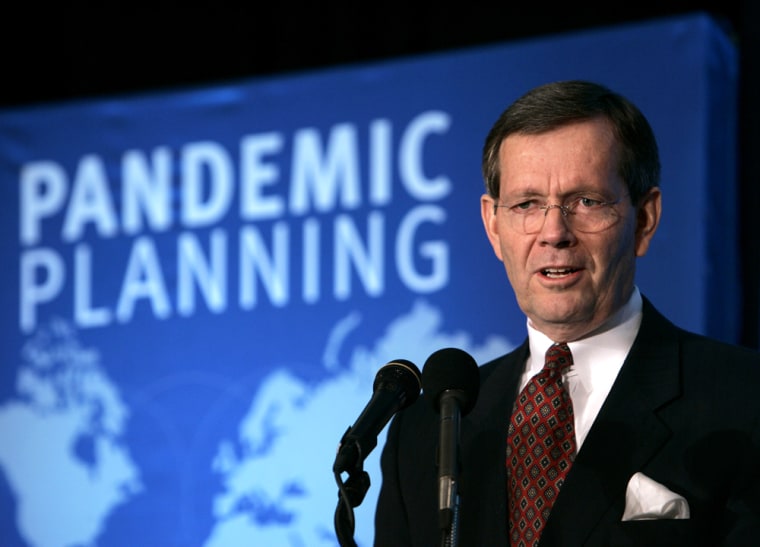Mike Leavitt, secretary of Health and Human Services, is on a road show preaching this message: The sky may be falling, but don’t expect the federal government to rush in to build a roof over your head.
The other day he met with a bunch of us here at NBC as part of a tour of news organizations to discuss the threat of pandemic flu.
“Any community that fails to prepare, expecting the federal government to step in at the last minute, will be tragically wrong," Leavitt says.
The federal government does have a role in preparing the nation for a pandemic, he says. It should watch for movement and mutations of viruses around the world, stockpile anti-viral medications including Tamiflu, and build up vaccine capability in a hurry. But let’s get real.
If a pandemic strikes, federal disease surveillance efforts will lose much of their importance. And how much the government's distribution of Tamiflu will help remains to be seen.
“Anything you say before seems alarmist, anything after seems inadequate” Leavitt says.
Demand for vaccine to skyrocket
With illness and death all around, everyone will fight to have an effective vaccine as quickly as possible. In the very best-case scenario, it would currently take a year, starting from the identification of a pandemic strain of influenza, until companies can manufacture enough vaccine for the entire U.S. population. Many experts believe the effort to shorten that turnaround time is progressing far too slowly.
The National Institute on Allergy and Infectious Disease is moving ahead on several fronts. But its efforts are not well-funded. President Bush asked for $7.1 billion for pandemic preparedness; Congress allocated $3.1 billion with only $44 million earmarked for flu vaccine development by NIAID.
With that money, NIAID is sponsoring trials of an H5N1 vaccine based on a virus isolated from a patient in Vietnam, as well a stockpiling some of the vaccine for use by "high priority" individuals. Just who exactly would be categorized high priority and get the vaccine remains an unanswered question.
Recent tests of the vaccine show you need 12 times as much as with the regular flu vaccine to get immunity. With current manufacturing capacity, companies could meet only a fraction of the need in the event of a pandemic. Tests are now under way to increase the vaccine's effectiveness using a chemical booster called an adjuvant, but critics say this research should have been done during the original vaccine studies, saving many months of delay.
Modernizing vaccine technology
NIAID also is paying drug companies to convert from 50-year-old technology, which grows viruses for vaccines in fertilized chicken eggs, to modern cell culture, the major manufacturing technique for most biological drugs these days.
In addition, research efforts are under way to develop an entirely new influenza vaccine that would attack the central part of the virus. This advance would eliminate the need for yearly flu shots and potentially protect against any pandemic threat. Scientists believe this type of vaccine is actually possible, but its development has not been given priority until now.
Dr. Anthony Fauci, director of NIAID, acknowledges that a lot of the research effort into vaccines could be going faster, but it has just now become top priority.
“You can indeed move science along with more money,” he says.
While the research continues, the federal government should embark on a program to ensure that almost everyone in the nation gets an annual flu shot. That won’t protect against pandemic flu, but it will build up the nation’s vaccine manufacturing capacity, which is now in tatters, so that it can more effectively respond if a pandemic does strike.
“I’ve been preaching this until it comes out of my ears for the past few months,” Fauci says.
Others have been pushing for such an effort for years. Indeed, it has been nine years since the H5N1 virus first jumped from birds to humans in Hong Kong and raised the specter of a pandemic. The time to create the means to rapidly develop a vaccine — the only reliable defense — is long overdue.
In order to adequately prepare for a possible outbreak, the government also must face a complex set of issues, including liability for drug companies, intellectual property rights and the nation's current chaotic vaccine distribution system.
But as Dr. Gregory Poland, a flu expert at the Mayo Clinic, writes, “To do otherwise with the pandemic clock ticking could prove to be too little too late."
This is the second edition of Second Opinion, a regular health column by NBC's Robert Bazell.
